| Léon Bakst | |
|---|---|
 Bakst's Self-portrait, 1893, oil on cardboard, 34 × 21 cm, the State Russian Museum, St. Petersburg, Russia Bakst's Self-portrait, 1893, oil on cardboard, 34 × 21 cm, the State Russian Museum, St. Petersburg, Russia | |
| Born | Leyb-Khaim Izrailevich Rosenberg 27 January 1866 (1866-01-27) Grodno, Grodno Governorate, Russian Empire |
| Died | 27 December 1924(1924-12-27) (aged 58) Rueil-Malmaison, near Paris |
| Nationality | Russian |
| Education | St. Petersburg Academy of Arts |
| Movement | Modernist, Orientalist themes |
Léon Bakst, born Leyb-Khaim Izrailevich Rosenberg (Russian: Леон (Лев) Самойлович Бакст, Лейб-Хаим Израилевич Розенберг; 27 January (8 February) 1866 – 27 December 1924), was a Russian painter and scene and costume designer of Jewish origin. He was a member of the Sergei Diaghilev circle and the Ballets Russes, for which he designed exotic, richly coloured sets and costumes. He designed the décor for such productions as Carnaval (1910), Spectre de la rose (1911), Daphnis and Chloe (1912), The Sleeping Princess (1921) and others.
Early life
Leyb-Khaim Izrailevich (later Samoylovich) Rosenberg was born in Grodno, into a middle-class Jewish family. As his grandfather was an exceptional tailor, the Tsar gave him a very good position, and he had a huge and wonderful house in Saint Petersburg. Later, when Leyb's parents moved to the capital, the boy Leyb would visit his grandfather's house every Saturday. He said that he had been very impressed as a youth by that house, always returning with pleasure. At the young age of twelve, Lejb won a drawing contest and decided to become a painter. However, the parents disapproved of it and even threw away his paints.
In several years the parents divorced and started new families, it became impossible to live with a step-mother, so the four siblings separated and rented their own place. As the eldest, Lejb was in charge of two sisters and brother, he 'took all kinds of painting work'. After graduating from gymnasium, he studied at the St. Petersburg Academy of Arts as a noncredit student, because he had failed the entry. He also worked part-time as a book illustrator, gaining admission into the Imperial Academy in 1883.
At the time of his first exhibition (1889) he took the surname of Bakst, though the origin of the pseudonym is still unclear. There are at least three versions, according to the main one, his mother's grandmother had the maiden name Bakster. Alexander Benois, a life-long friend of Leon, recalled that 'Leo gave a prolonged and confusing explanation that the surname was taken after some of distant relatives'.
At the beginning of the 1890s, Bakst exhibited his works with the Society of Watercolourists. From 1893 to 1897 he lived in Paris, where he studied at the Académie Julian. He still often visited Saint Petersburg. After the mid-1890s, Bakst became a member of the circle of writers and artists formed by Sergei Diaghilev and Benois, who in 1899 founded the influential periodical Mir iskusstva, meaning "World of Art". His graphics for this publication brought him fame.
Career
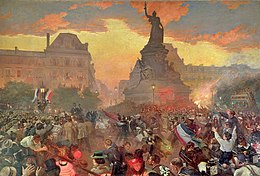

Bakst continued painting, producing portraits of Filipp Malyavin (1899), Vasily Rozanov (1901), Andrei Bely (1905), Zinaida Gippius (1906). He also worked as an art teacher for the children of Grand Duke Vladimir Alexandrovich of Russia. In 1902, he took a commission from Tsar Nicholas II to paint Admiral Avellan and Russian sailors arriving in Paris, a painting he started there, during the celebrations from the 17 to 25 October 1893. However, it took him 8 years to finish this work.
In 1898, he showed his works in the Diaghilev-organized First Exhibition of Russian and Finnish Artists; in World of Art exhibitions, as well as the Munich Secession, exhibitions of the Union of Russian Artists, etc. During the Russian Revolution of 1905, Bakst worked for the magazines Zhupel, Adskaya Pochta, Mir Iskusstva (magazine) [ru], and Satirikon [ru], then for an art magazine called Apollon.
Beginning in 1909, Bakst worked mostly as a stage-designer, designing sets for Greek tragedies. In 1908, he gained attention as a scene-painter for Diaghilev with the Ballets Russes. He produced scenery for Cléopâtre (1909), Scheherazade (1910), Carnaval (1910), Narcisse (1911), Le Spectre de la Rose (1911), L'après-midi d'un faune (1912) and Daphnis et Chloé (1912). During this time, Bakst lived in western Europe because, as a Jew, he did not have the right to live permanently outside the Pale of Settlement in the Russian Empire .
- Selected stage designs
-
 For Cléopâtre by Mikhail Fokine; 1910.
For Cléopâtre by Mikhail Fokine; 1910.
-
 For Daphnis et Chloé by Maurice Ravel; 1912, watercolour on paper, 19×27 cm, Houghton Library.
For Daphnis et Chloé by Maurice Ravel; 1912, watercolour on paper, 19×27 cm, Houghton Library.
-
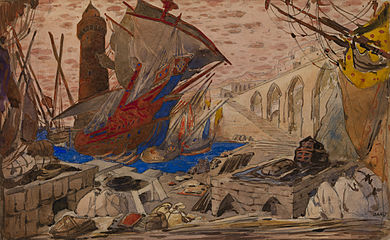 For La Pisanelle où la Mort parfumée by Gabriele D'Annunzio; 1913, pencil, watercolour and gouache on cardboard, 24×39 cm, private collection.
For La Pisanelle où la Mort parfumée by Gabriele D'Annunzio; 1913, pencil, watercolour and gouache on cardboard, 24×39 cm, private collection.
-
 The Sleeping Beauty by Pyotr Ilyich Tchaikovsky; 1921, pencil and watercolour on paper, 48×67 cm, Thyssen-Bornemisza Museum.
The Sleeping Beauty by Pyotr Ilyich Tchaikovsky; 1921, pencil and watercolour on paper, 48×67 cm, Thyssen-Bornemisza Museum.
- Selected costume designs
-
 For the Negro Boy in Scheherazade by Nikolai Rimsky-Korsakov; 1910.
For the Negro Boy in Scheherazade by Nikolai Rimsky-Korsakov; 1910.
-
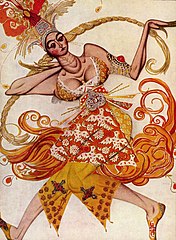 For the Firebird in The Firebird; 1910.
For the Firebird in The Firebird; 1910.
-
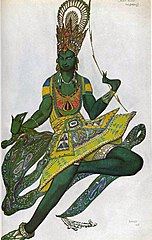 For The Blue God in Le Dieu bleu by Reynaldo Hahn; 1911.
For The Blue God in Le Dieu bleu by Reynaldo Hahn; 1911.
-
 For Josephslegende by Hugo von Hofmannsthal and Harry Graf Kessler; 1914, private collection.
For Josephslegende by Hugo von Hofmannsthal and Harry Graf Kessler; 1914, private collection.
-
 For the Masked Man in The Good-Humoured Ladies by Léonide Massine; 1917.
For the Masked Man in The Good-Humoured Ladies by Léonide Massine; 1917.
-
 For the Puppet Girl in La Boutique fantasque by André Derain; 1919.
For the Puppet Girl in La Boutique fantasque by André Derain; 1919.
-
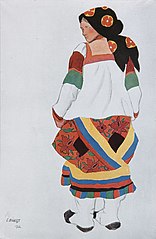 For the Russian Peasant Woman in Old Moscow; 1922.
For the Russian Peasant Woman in Old Moscow; 1922.
-
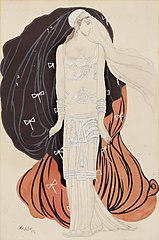 For Ida Rubinstein as Phaedra in Phèdre by Racine; 1923, Museum of Avant-Garde Mastery.
For Ida Rubinstein as Phaedra in Phèdre by Racine; 1923, Museum of Avant-Garde Mastery.

Despite being known for his work as a stage designer, art was also commissioned by various English families during the Art Deco era. During this time, he produced such works as the Sleeping Beauty series for James and Dorothy de Rothschild at Waddesdon Manor in 1913. The story is depicted in seven panels that line the walls of an oval, theatrical styled "Bakst room" in the Buckinghamshire manor house.
During his visits to Saint Petersburg, he taught in Zvantseva's school, where one of his students was Marc Chagall (1908–1910). Bakst described Chagall as a favorite, because when told to do something, he would listen carefully, but then he would take his paint and his brushes and do something completely different from the assignment.

In 1914, Bakst was elected a member of the Imperial Academy of Arts. Bakst's comprehensive, many-sided talent showed itself in various areas — he worked as a designer of clothes, set decorations, interiors, textile, etc. Apart from a series of interior designs for the Rothschilds, he also designed exhibitions for ‘Mir Iskusstva’ society and occupied a post of a furniture and interior designer at ‘Sovremennoe Iskusstvo’ (rus. ‘Modern Art’). American silk industry businessman Arthur Selig invited Bakst to create textile design, their collaboration had great success.
During this period his work was widely shown in the United States. Martin Birnbaum, manager of the Berlin Photographic Company in New York City, organized an exhibition of Bakst's work in 1913 in New York that then traveled to Detroit (1913), Buffalo (1914), Cincinnati (1914), Chicago (1914) and Montreal (1914). After the Revolution of 1917 Leon's sister died from hunger in Russia. When Bakst received the news, he suffered a nervous breakdown, becoming so ill that he couldn't tolerate any irritants such as light, noise, or touch. His servant, Linda, exploited his condition to steal his money — she took all the honoraria that came to the house and intimidated the artist, forcing him to include her and her husband as heirs to his will. By chance he managed to send a note to an influential friend and patron Alice Warder Garrett (1877–1952), an art philanthropist, who helped his sister Sofia rescue Léon. They first met in Paris in 1914, when Mrs. Garrett was accompanying her diplomat husband in Europe, Bakst soon depended upon Garrett as both a confidante and agent.
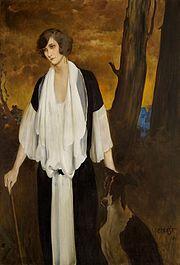
In 1922, Bakst broke off his relationship with Diaghilev and the Ballets Russes. During this year, he visited Baltimore and, specifically Evergreen House — the residence of his American friend Alice Garrett. Garrett became Bakst's representative in the United States upon her return home in 1920, organizing two exhibitions of the artist's work at New York's Knoedler Gallery, as well as subsequent traveling shows. When in Baltimore, Bakst re-designed the dining room of Evergreen into a shocking acidic yellow and 'Chinese' red confection. The artist transformed the house's small c. 1885 gymnasium into a colourfully Modernist private theatre. This is believed to be the only extant private theatre designed by Bakst.

Léon Bakst was also a prolific writer, his literary legacy in three languages includes novels, numerous publications in magazines, critics, essays, letters to friends and colleagues.
Bakst died on 27 December 1924, in a clinic in Rueil Malmaison, near Paris, from lung problems (oedema). His many admirers amongst the most famous artists of the time, poets, musicians, dancers and critiques, formed a funeral procession to accompany his body to his final resting place, in the Cimetière des Batignolles, in Paris 17th Arrondissement, during a very moving ceremony.
In late 2010, the Victoria and Albert Museum in London presented an exhibit of Bakst's costumes and prints.
Cultural depictions
- Anna Pavlova, film by Emil Loteanu; portrayed by Igor Dmitriev (1983).
Selected works
-
 Bakst's Portrait of Alexander Benois; 1898, watercolour and pastel on paper, 65×100 cm, Russian Museum.
Bakst's Portrait of Alexander Benois; 1898, watercolour and pastel on paper, 65×100 cm, Russian Museum.
-
 Dinner; 1902, oil on canvas, 150×100 cm, Russian Museum.
Dinner; 1902, oil on canvas, 150×100 cm, Russian Museum.
-
 Stage furniture design for Le Spectre de la Rose by Michel Fokine; c. 1911.
Stage furniture design for Le Spectre de la Rose by Michel Fokine; c. 1911.
-
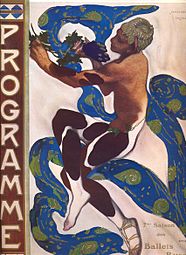 Poster for Afternoon of a Faun; 1912, private collection.
Poster for Afternoon of a Faun; 1912, private collection.
-
 Drawing of a Horse Drinking; c. early 20th-century, pencil, watercolour and gouache on paper laid on cardboard, 33×49 cm, private collection.
Drawing of a Horse Drinking; c. early 20th-century, pencil, watercolour and gouache on paper laid on cardboard, 33×49 cm, private collection.
-
 Textile Print; c. 1922.
Textile Print; c. 1922.
-
 Stamp for the 150th Anniversary of Birth of Leon Bakst; 2016, Belposhta.
Stamp for the 150th Anniversary of Birth of Leon Bakst; 2016, Belposhta.
- The Sleeping Beauty series; 1913–1922, oil on canvas, Waddesdon Manor
-
 The Bad Fairy Visits the Christening; 212×84 cm
The Bad Fairy Visits the Christening; 212×84 cm
-
 The Good Fairy's Promise; 210×140 cm
The Good Fairy's Promise; 210×140 cm
-
 The Princess Pricks Her Finger on a Spinning Wheel; 213×143 cm
The Princess Pricks Her Finger on a Spinning Wheel; 213×143 cm
-
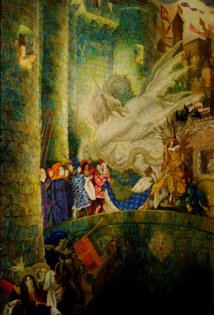 The Aged King Pleads with the Good Fairy; 212×143 cm
The Aged King Pleads with the Good Fairy; 212×143 cm
-
 The Princess and the Court Fall Asleep for a Hundred Years; 212×171 cm
The Princess and the Court Fall Asleep for a Hundred Years; 212×171 cm
-
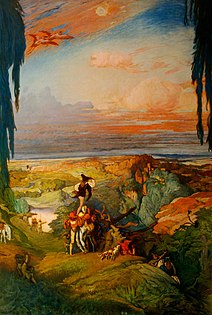 The Prince Out Hunting Sees the Castle Where the Princess Lies Sleeping; 212×142 cm
The Prince Out Hunting Sees the Castle Where the Princess Lies Sleeping; 212×142 cm
-
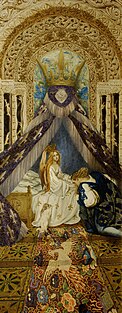 The Prince Discovers the Princess and Wakes Her with a Kiss; 212×84 cm
The Prince Discovers the Princess and Wakes Her with a Kiss; 212×84 cm
See also
Citations
- ^ [https://archive.org/details/dictionaryofart03turn/page/86/mode/2up "Bakst, Leon", by Maarten Wurfbain, in The Dictionary of Art (Grove Press, 1998) p.86
- БАКСТ, ЛЕВ САМОЙЛОВИЧ
- Бакст Лев Самойлович
- ^ "Bakst Lev Samoilovich", by V. A. Kulakov, Great Russian Encyclopedia online
- "Леон Бакст". Archived from the original on 22 February 2014. Retrieved 2 March 2016.
- Norwich, John Julius (1985–1993). Judge, Harry George; Toyne, Anthony (eds.). Oxford Illustrated Encyclopedia. Oxford, England: Oxford University Press. p. 29. ISBN 0-19-869129-7. OCLC 11814265.
- "Лев Бакст в десяти деталях: навстречу выставке художника в Русском музее" [10 Facts about Leon Bakst] (in Russian). Fontanka. 21 February 2016. Retrieved 10 December 2020.
- ^ Elena Terkel (2008). "Leon Bakst: His family and His Art" (PDF). The Tretyakov Gallery, № 1. p. 63. Retrieved 3 May 2017.
- Usova 2016, p. 72-82.
- Bakst
- ^ Бакст Л. С.
- Mikotowicz, Thomas J. "Bakst, Léon". In Thomas J. Mikotowicz, Theatrical designers: An International Biographic Dictionary. New York: Greenwood, 1992. ISBN 0313262705. p. 17.
- ^ Esaulova, A. (9 May 2016). "Штрихи к портрету: 8 историй из бурной жизни Леона Бакста" [8 Stories from Vivid Life of Leon Bakst] (in Russian). Arthive. Retrieved 10 December 2020.
- Codell, Julie," Convergences: Art History, Museums and Scholar-Agent Martin Birnbaum's Transatlantic Art for the Public," Art Markets, Agents and Collectors, eds. A. Turpin and S. Bracken. Bloomsbury, 2021, 316-327
- Bowlt et al. 2008, p. 80-82.
- "Biography of Léon Bakst - Victoria and Albert Museum". Vam.ac.uk. Archived from the original on 11 April 2009. Retrieved 16 May 2012.
General sources
- Marc Chagall, My Life, St.-Petersburg, Azbuka, 2000, ISBN 5-267-00200-3
- Codell, Julie," Convergences: Art History, Museums and Scholar-Agent Martin Birnbaum's Transatlantic Art for the Public," Art Markets, Agents and Collectors, eds. A. Turpin and S. Bracken. Bloomsbury, 2021, 316-327
- Léon Bakst, Serov et moi en Grèce, translation and introduction by Olga Medvedkova, preface by Véronique Schiltz, TriArtis Editions, 2015, 128 p., 24 illustrations (ISBN 978-2-916724-56-0; OCLC 902790439)
- Usova, M. N. (2016). ""Трехфамилие" Бакста: Рабинович, Розенберг, Бакст. От Лейбы Рабиновича до Леона Бакста" [Three Surnames of Leon Bakst: Rabinovich, Rosenberg, Bakst. From Leyb Rabinovich to Leon Bakst]. Journal of the Vaganova State Ballet Academy (in Russian). 5 (46): 72–82.
- Bowlt, J. E.; Chernukhina, A.; Kovaleva, O.; Terkel, E. (2008). ""Words of Magic": The Literary heritage of Leon Bakst" (PDF). The Tretyakov Gallery (1): 80–82.
External links
- The seven Sleeping Beauty panels at Waddesdon Manor
- Léon Bakst at FMD

- W.H. Crain Costume and Scene Design Collection at the Harry Ransom Center
- Working for Diaghilev Archived 3 July 2015 at the Wayback Machine Exhibition at the Groninger Museum
- Léon Bakst (1866–1924) Artwork Images, Exhibitions, Reviews at wwar.com
- An artwork by Léon Bakst at the Ben Uri site
- Works by Léon Bakst at the Russian Art Gallery
- Video on YouTube
- Art Signature Dictionary - See Léon Bakst's signature, although the police seizure of counterfeit
- Bakst theatre and performance collection at the Victoria and Albert Museum
- Evergreen Museum and Library Archived 25 June 2015 at the Wayback Machine - Collection includes original stage sets, costume designs, and other related works.
- Leon Bakst designs, circa 1911–1923, held by the Billy Rose Theatre Division, New York Public Library for the Performing Arts
- Diaghilev and the Ballets Russes, 1909–1929: When Art Danced with Music 2013 exhibition at the National Gallery of Art in Washington, D.C.
- Bakst collection Archived 19 August 2016 at the Wayback Machine at the McNay Art Museum
- 1866 births
- 1924 deaths
- 19th-century painters from the Russian Empire
- 20th-century Russian painters
- Art Nouveau painters
- Ballet designers
- Ballets Russes and descendants
- Belarusian Jews
- Burials at Batignolles Cemetery
- French people of Belarusian-Jewish descent
- Emigrants from the Russian Empire to France
- Jewish painters
- Orientalism
- Orientalist painters
- People from Grodnensky Uyezd
- People from Grodno
- Russian costume designers
- Russian male painters
- Russian scenic designers
- Scenographers
- Waddesdon Manor
- Mir iskusstva artists